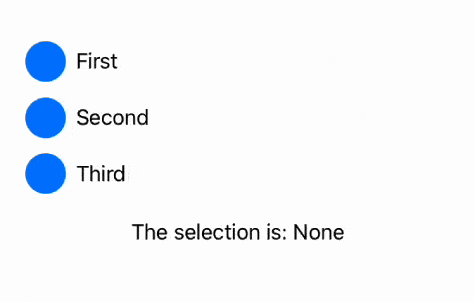SwiftUI Radio Buttons
Reading time: 2 min
This recipe shows how to add radio buttons in SwiftUI. Each radio button will have a customizable appearance and will be a part of a single radio button group.
The end result looks like this:

First, we'll define a RadioButton view. It has two UI components to it - button and label, both of which are customizable. The button part should change appearance based on if the radio button is selected or not. Also, each radio button has a unique tag associated with it that tells it apart from other radio buttons in a group:
struct RadioButton<Tag, CircleButton, Label>: View
where Tag : Hashable, CircleButton : View, Label : View {
let tag: Tag
@Binding var selection: Tag?
@ViewBuilder let button: (Bool) -> CircleButton
@ViewBuilder let label: () -> Label
var body: some View {
Button {
selection = tag
} label: {
HStack {
button(selection == tag)
label()
}
}
.buttonStyle(.plain)
}
}Next, a RadioButtonGroup renders a collection of radio buttons, all of whom share the same appearance and the same selection state - only one can be selected at the time. We'll also support two orientation modes - horizontal and vertical, respectively.
struct RadioButtonGroup<Tag, CircleButton, Label>: View
where Tag : Hashable, CircleButton : View, Label : View {
@Binding var selection: Tag?
let orientation: Orientation
let tags: [Tag]
@ViewBuilder let button: (Bool) -> CircleButton
@ViewBuilder let label: (Tag) -> Label
var body: some View {
if orientation == .horizonal {
HStack(alignment: .top) {
radioButtons
}
} else {
VStack(alignment: .leading) {
radioButtons
}
}
}
@ViewBuilder private var radioButtons: some View {
ForEach(tags, id: \.self) { tag in
RadioButton(tag: tag, selection: $selection, button: button) {
label(tag)
}
}
}
enum Orientation {
case horizonal, vertical
}
}If you're using SwiftUI 4 (iOS 16, macOS 12.4), you can simplify the above code by utilizing AnyLayout:
struct RadioButtonGroup<Tag, CircleButton, Label>: View
where Tag : Hashable, CircleButton : View, Label : View {
@Binding var selection: Tag?
let orientation: Orientation
let tags: [Tag]
@ViewBuilder let button: (Bool) -> CircleButton
@ViewBuilder let label: (Tag) -> Label
var body: some View {
((orientation == .horizonal)
? AnyLayout(HStackLayout(alignment: .top))
: AnyLayout(VStackLayout(alignment: .leading))) {
ForEach(tags, id: \.self) { tag in
RadioButton(tag: tag, selection: $selection, button: button) {
label(tag)
}
}
}
}
enum Orientation {
case horizonal, vertical
}
}Lastly, here's some sample code to showcase RadioButtonGroup in action:
struct RadioButtonTest: View {
@State private var selection: Option?
var body: some View {
VStack(alignment: .leading, spacing: 20) {
RadioButtonGroup(selection: $selection,
orientation: .vertical,
tags: Option.allCases,
button: { isSelected in
ZStack {
Circle()
.foregroundColor(.blue)
.frame(width: 32, height: 32)
if isSelected {
Circle()
.foregroundColor(Color.white)
.frame(width: 16, height: 16)
}
}
},
label: { tag in
Text("\(tag.description)")
})
Text("The selection is: \(selection?.description ?? "None")")
.frame(maxWidth: .infinity)
}
.padding(20)
}
enum Option: CaseIterable, CustomStringConvertible {
case first, second, third
var description: String {
switch self {
case .first:
return "First"
case .second:
return "Second"
case .third:
return "Third"
}
}
}
}